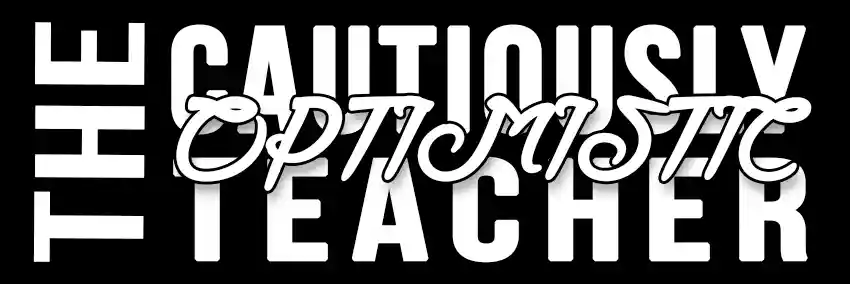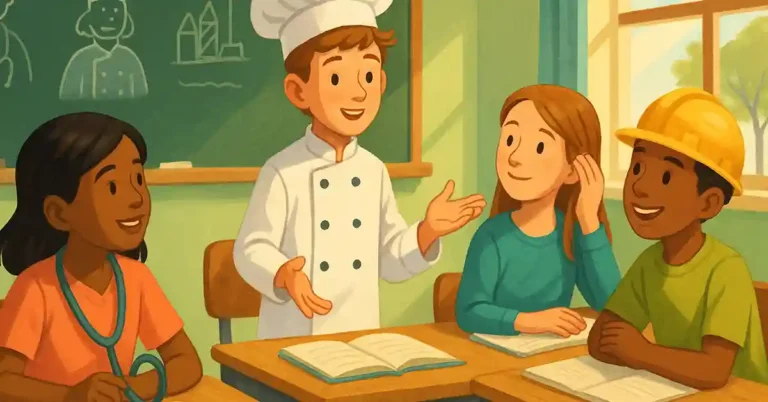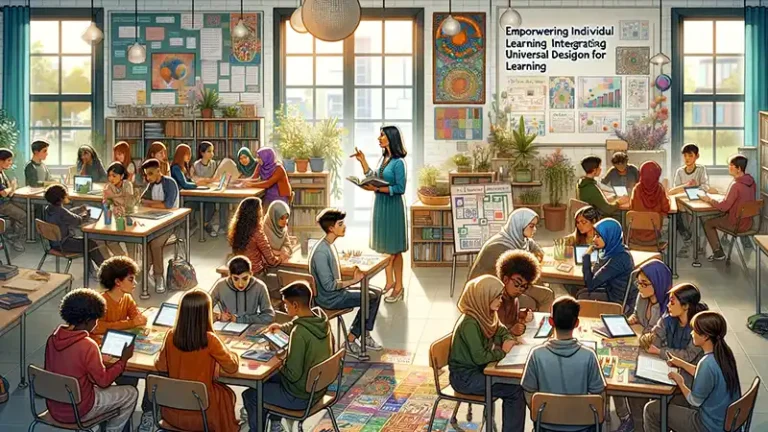Effective Scaffolding Techniques for Diverse Classrooms
Navigating the vibrant tapestry of today’s classrooms can sometimes feel akin to steering a ship through ever-changing seas. Each student brings a unique set of experiences, knowledge, and backgrounds, creating a symphony of learning styles. Herein lies the challenge for educators: How can one method resonate with all, creating a harmonious learning environment? Enter the concept of scaffolding, a teacher’s secret ingredient for ensuring no learner is left behind.
What is Scaffolding, Anyway?
At its core, scaffolding is an educational technique where the teacher models or demonstrates how to solve a problem, then gradually steps back, handing the responsibility over to the students. Think of it as building a structure. Initially, there are supports in place to ensure stability. As the structure becomes stronger, these supports are reduced, allowing it to stand independently. Similarly, in an educational context, students are provided with a strong foundational support that gradually reduces as their confidence and understanding grow.
Differentiated Instruction: The Heartbeat of Diverse Classrooms
In an ideal world, every student would learn in the same way and at the same pace. But our classrooms reflect the real world, teeming with diversity and a myriad of learning approaches. Recognizing this, differentiated instruction emerges as a radiant beacon.
Differentiated instruction is all about tailoring teaching methods to individual student needs. It’s not about making it easier for some or harder for others, but making learning meaningful for everyone. When educators tap into the power of differentiated instruction, they recognize and validate the unique attributes of each student, ensuring everyone feels seen, heard, and understood.
Understanding Diverse Classrooms
The Vibrant Spectrum of Diverse Classrooms
Each classroom is a microcosm of the world outside its walls. If we peek inside, what we’ll find is a colorful mosaic of students, each piece distinct, and yet, together, they form a coherent and beautiful picture. So, what makes a classroom “diverse”?
Cultural and Linguistic Backgrounds: From the languages spoken at home to the cultural traditions celebrated, students bring with them a rich tapestry of experiences that can influence how they perceive and engage with the world.
Learning Abilities and Styles: While some students might be auditory learners, preferring to listen and speak, others might lean towards visual or kinesthetic learning, requiring more tangible or visual experiences.
Socioeconomic Differences: Economic backgrounds can influence not just the resources available to students but also their perspectives and aspirations.
Experiences and Worldviews: Personal experiences, whether it’s traveling to different countries or simply interacting with diverse community groups, can vastly affect how students understand concepts and relate to others.
Differentiated Instruction: Not a Luxury, but a Necessity
Given the variety we find in our classrooms, the one-size-fits-all teaching approach seems, at best, archaic. Students don’t come from cookie cutters; they’re as varied as the stars in the sky. Here’s why differentiated instruction isn’t just “nice-to-have” but rather an “essential”:
Meeting Individual Needs: Every student deserves an education tailored to their strengths, needs, and prior knowledge. Differentiated instruction ensures that students aren’t just passive recipients but active participants in their learning journey.
Boosting Engagement and Motivation: When students see that lessons are relevant to them, that they’re not just generic tasks, they’re more likely to engage and invest themselves in the learning process.
Promoting a Positive Learning Environment: By recognizing and celebrating differences, educators foster an environment where students feel valued and included. It sends a potent message: You matter. Your learning matters.
Basics of Scaffolding

From Construction Sites to Classrooms: The Origins of Scaffolding
While today we associate scaffolding with education, its origins are surprisingly industrial. The term “scaffolding” is borrowed from the construction world, where builders use temporary structures to support workers as they construct or repair buildings. Much like its construction counterpart, educational scaffolding offers support, allowing students to reach new heights in their learning.
The idea of scaffolding in education was popularized in the 20th century by the renowned psychologist Lev Vygotsky. He introduced the concept of the “Zone of Proximal Development” (ZPD) – the gap between what a learner can do alone and what they can do with help. Scaffolding functions as the bridge across this gap, assisting learners to progress from their current abilities to new potential.
Scaffolding: A Pillar in Modern Education
In the fast-evolving world of contemporary education, why has scaffolding cemented its place as a pivotal strategy? Let’s unravel its significance:
Fostering Independence: By providing initial support and then gradually withdrawing it, scaffolding teaches students not only the subject at hand but also the invaluable skill of independent problem-solving.
Adaptable Support: Just as every building is unique, requiring different scaffolds, each student’s needs are distinct. Scaffolding allows educators to adapt and provide tailored support, ensuring that every student can climb confidently.
Bridging Knowledge Gaps: Scaffolding acts as a connector, linking prior knowledge to new information. By doing so, it ensures a smoother and more meaningful learning experience.
Encouraging Active Participation: No longer are students mere spectators. With scaffolding, they become active participants, delving deeper, questioning more, and engaging fully in their educational journey.
Effective Scaffolding Techniques for Differentiated Instruction
Modeling: Showing the Way: Modeling is a technique where educators demonstrate a task, strategy, or thought process before students attempt it on their own. By offering a clear example, students have a reference point for their attempts.
Clarity: By showing, rather than just telling, concepts become tangible and easier to grasp.
Boosted Confidence: Seeing a task completed from start to finish can demystify it, giving students the confidence to try themselves.
Consistency: It provides a standard approach or method, ensuring that all students have the same foundational understanding.
Real-world Classroom Examples:
In a writing class, an educator might draft an essay live, illustrating the process of brainstorming, outlining, drafting, and revising.
In a math lesson, a teacher might solve a problem step-by-step on the board, explaining their thought process along the way.
Questioning: Sparking the Mind
Open-ended vs. Guided Questions:
Open-ended questions encourage broader thinking, allowing students to explore and articulate their thoughts freely. Guided questions, on the other hand, steer students towards a specific answer or concept.
The Socratic Method:
Originating from the ancient philosopher Socrates, this technique involves asking a series of questions to stimulate critical thinking and draw out underlying principles and beliefs. It’s less about providing answers and more about fostering deeper understanding through inquiry.
Think-Alouds: Externalizing the Internal
The Power of Verbalizing Thought Processes:
Think-alouds involve vocalizing one’s thoughts while performing a task. This makes the invisible, visible—giving students a window into the cognitive processes behind a task.
Practical Classroom Application:
A literature teacher might read a passage from a novel and vocalize their analysis, showing students how to unpack themes, motifs, and character developments.
In a science experiment, educators can verbalize their hypotheses, predictions, and observations, modeling the scientific thought process.
Graphic Organizers: Painting a Clear Picture
Graphic organizers are visual tools that help represent and organize knowledge. They can simplify complex ideas, making them more digestible.
Examples Suitable for Diverse Classrooms:
Mind maps to explore the central theme and its related concepts.
Venn diagrams to compare and contrast ideas or concepts.
Flowcharts to outline processes or sequences in subjects like history or biology.
Peer Tutoring and Collaborative Learning: Strength in Unity
Benefits of Peer-Assisted Learning:
Diverse Perspectives: Students can offer unique insights, different from an educator’s approach.
Enhanced Engagement: Working closely with peers can make tasks more engaging and relatable.
Reinforced Understanding: Teaching a peer reinforces the tutor’s understanding of the material.
Strategies for Implementation:
Structured Pairing: Pair more proficient students with those who might be struggling in a specific area.
Group Projects: Create diverse groups where students can bring their strengths to the table, ensuring a mix of skills and knowledge.
Role Reversal: Allow students to take turns playing the role of “teacher” and “learner,” promoting empathy and understanding.
Harnessing the Power of Scaffolding Techniques
Differentiated instruction, when combined with these scaffolding techniques, becomes a potent tool. From modeling to collaborative learning, educators have an arsenal at their disposal, ensuring that every student’s learning journey is not just supported but celebrated. As we traverse the path of education, these techniques light the way, ensuring no student walks in darkness.
Common Obstacles in Scaffolding for Diverse Classrooms

Navigating the Hurdles
In the endeavor to scaffold effectively in diverse classrooms, educators often face a unique set of challenges. Recognizing these obstacles is the first step towards crafting meaningful solutions.
Varied Learning Paces: In a diverse classroom, students often progress at different rates. While some might grasp a concept instantly, others might need more time and support.
Cultural and Linguistic Barriers: Students from different backgrounds might interpret and respond to scaffolding techniques differently due to their cultural or linguistic backgrounds.
Resource Limitations: Especially in larger classrooms, there might be a shortage of resources – be it time, materials, or even technological tools.
Inconsistent Prior Knowledge: Diverse classrooms often mean a broad spectrum of prior knowledge, making it challenging to find a starting point that caters to everyone.
Over-scaffolding: There’s a risk of providing too much support, which can prevent students from becoming independent learners.
Tips to Overcome Challenges
Differentiated Scaffolding: Just as instruction is differentiated, scaffolding should be too. Group students based on their current understanding and scaffold accordingly.
Culturally Responsive Teaching: Invest time in understanding the cultural backgrounds of your students. Tailor your scaffolding methods to be inclusive and relevant to every student’s experience.
Collaborative Solutions: Engage students in peer tutoring or group activities. Often, students can bridge gaps in understanding by explaining concepts to their peers in ways teachers might not have considered.
Assess and Reassess: Regularly check in on students’ understanding. This can be through informal quizzes, discussions, or feedback sessions. Adjust your scaffolding based on their feedback and progress.
Strike a Balance: While scaffolding is essential, it’s crucial to know when to step back. Give students opportunities to grapple with challenges independently before stepping in with support.
Professional Development: Continuously upskill by attending workshops or seminars on scaffolding. Learning from experts and peers can provide fresh insights and strategies.
Conclusion
Reaffirming the Pillars of Learning
Scaffolding, with its roots deeply embedded in the bedrock of educational philosophy, remains an indispensable tool in our ever-evolving classrooms. It’s not merely a method but a mindset—understanding that every student stands on a unique platform of knowledge and experience, and our role is to bridge the gaps, ensuring no learner is left behind.
The Journey of Continuous Adaptation
The world of education is dynamic, with new challenges and opportunities emerging every day. Scaffolding in diverse classrooms isn’t a one-size-fits-all solution but a flexible framework that must be continuously molded and adapted. As educators, it’s our responsibility, and indeed our privilege, to be lifelong learners. Every challenge faced is an opportunity to adapt, to learn, and to grow.
To all educators navigating the vibrant mosaic of diverse classrooms, take heart. Your dedication, resilience, and passion lay the foundation for countless success stories. As you scaffold your students’ journeys, remember that you, too, are supported by a community of educators worldwide, all united in a shared mission.
Additional Resources
“Mind in Society: The Development of Higher Psychological Processes” by L.S. Vygotsky – Delve into the origins of scaffolding and the Zone of Proximal Development.
Edutopia’s Resource on Scaffolding: An array of articles, videos, and discussions on effective scaffolding techniques.







